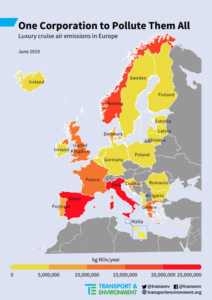Carnival Corporation emitted about 10 times more sulphur oxide (SOx) around European coasts than did all 260 million European cars in 2017, a new analysis by sustainable transport group Transport & Environment reveals. As for Royal Caribbean Cruises, it is second, with yet four times worse than the European car fleet.
In absolute terms, Spain, Italy and Greece, closely followed by France and Norway, are the European countries most exposed to SOx air pollution from cruise ships while Barcelona, Palma de Mallorca and Venice are the most impacted European port cities, followed by Rome and Southampton.
[smlsubform prepend=”GET THE SAFETY4SEA IN YOUR INBOX!” showname=false emailtxt=”” emailholder=”Enter your email address” showsubmit=true submittxt=”Submit” jsthanks=false thankyou=”Thank you for subscribing to our mailing list”]
These countries are so exposed because they are major tourist destinations, but also because they have less strict marine sulphur fuel standards which allows cruise ships to burn the dirtiest most sulphurous fuel all along their coastlines.
Namely, NOx emissions from cruise ships in Europe also heavily affect some cities, equivalent to about 15% of the nitrogen oxides (NOx) emitted by Europe’s passenger car fleet in a year, the report finds.
For example, in Marseille, 57 cruise ships emitted in 2017 almost as much NOx as one-quarter of the city’s 340,000 passenger cars. Along the coasts of countries such as Norway, Denmark, Greece, Croatia and Malta a handful of cruise ships are also responsible for more NOx than the majority of their domestic car fleet.
For this reason, Transport & Environment urged Europe to implement a zero-emission port standard as soon as possible, which could then be extended to other ship types. The report also suggests extending emission control areas (ECAs), currently in place only in the North and Baltic Seas and English Channel, to the rest of the European seas.
It also recommends regulating NOx emissions from existing ships, which are currently exempt from NOx standards applying in emission control areas.
Faig Abbasov, shipping policy manager at T&E, commented on the report:
Luxury cruise ships are floating cities powered by some of the dirtiest fuel possible. Cities are rightly banning dirty diesel cars but they’re giving a free pass to cruise companies that spew out toxic fumes that do immeasurable harm both to those on board and on nearby shores. This is unacceptable
He also added that toady there are enough mature technologies to clean up cruise ships. Specifically, shore-side electricity can help reduce in-port emissions, while batteries are a solution for shorter distances and hydrogen technology can power even the biggest cruise ships.


































































